Stoa of Attalos
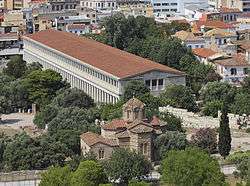
The Stoa of Attalos (also spelled Attalus) was a stoa (covered walkway or portico) in the Agora of Athens, Greece.[1] It was built by and named after King Attalos II of Pergamon, who ruled between 159 BC and 138 BC. The current building was reconstructed from 1952 -1956 by American architects.
Description
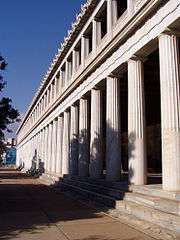
Typical of the Hellenistic age, the stoa was more elaborate and larger than the earlier buildings of ancient Athens. The stoa's dimensions are 115 by 20 metres (377 by 66 ft) and it is made of Pentelic marble and limestone. The building skillfully makes use of different architectural orders. The Doric order was used for the exterior colonnade on the ground floor with Ionic for the interior colonnade. This combination had been used in stoas since the Classical period and was by Hellenistic times quite common. On the first floor of the building, the exterior colonnade was Ionic and the interior Pergamene. Each story had two aisles and twenty-one rooms lining the western wall. The rooms of both stories were lighted and vented through doorways and small windows located on the back wall. There were stairways leading up to the second story at each end of the stoa. The building is similar in its basic design to the Stoa that Attalos' brother, and predecessor as king, Eumenes II had erected on the south slope of the Acropolis next to the theatre of Dionysus. The main difference is that Attalos' stoa had a row of rooms at the rear on the ground floor that have been interpreted as shops.
History
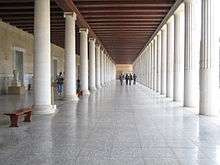
The stoa is identified as a gift to the city of Athens for the education that Attalos received there. A dedicatory inscription on the architrave is engraved as built by Attalos II, ruler of Pergamon from 159 BC to 138 BC.
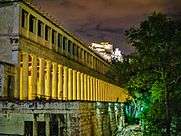
The stoa was in frequent use until it was destroyed by the Heruli in 267. The ruins became part of a fortification wall, which made it easily seen in modern times. In the 1950s, the Stoa of Attalos was fully reconstructed and the Ancient Agora Museum was created by the American School of Classical Studies at Athens,[2] with funding donated by the Rockefeller family. The building is particularly important in the study of ancient monuments because the reconstruction of 1952–1956 is as faithful a replica of the original building as was possible, given the limitations of archaeology.
The ceremony of the signing of the 2003 Treaty of Accession of 10 countries – Cyprus, the Czech Republic, Estonia, Latvia, Lithuania, Hungary, Malta, Poland, Slovakia, and Slovenia – to the European Union was conducted in the Stoa of Attalos on 16 April 2003.
Museum of the Ancient Agora
The Stoa of Attalos houses the Museum of the Ancient Agora. Its exhibits are mostly connected with the Athenian democracy. The collection of the museum includes clay, bronze and glass objects, sculptures, coins and inscriptions from the 7th to the 5th century BC, as well as pottery of the Byzantine period and the Turkish conquest.
Gallery
 Amphora with bird procession. Geometric period, 750-725 BC
Amphora with bird procession. Geometric period, 750-725 BC Casserole and brazier (6th/4th century BC)
Casserole and brazier (6th/4th century BC) Woman kneeling before an altar. Attic red-figure kylix, 5th BC
Woman kneeling before an altar. Attic red-figure kylix, 5th BC Statue of a goddess, probably Aphrodite (early 4th century BC)
Statue of a goddess, probably Aphrodite (early 4th century BC) Acroterial statue of Winged Nike, flying to the right (4th BC)
Acroterial statue of Winged Nike, flying to the right (4th BC) The Kleroterion was used for the jury selection system in Athens
The Kleroterion was used for the jury selection system in Athens Ostracon bearing the name of Cimon
Ostracon bearing the name of Cimon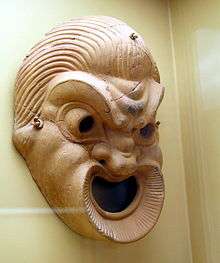 Theatre mask, dating from the 4th/3rd century BC
Theatre mask, dating from the 4th/3rd century BC Statuette of a satyr
Statuette of a satyr Statuette of Farnese Hercules
Statuette of Farnese Hercules Bust of Herodotus (2nd century AD)
Bust of Herodotus (2nd century AD) Bust of the Roman emperor Antoninus Pius
Bust of the Roman emperor Antoninus Pius Byzantine plate (12th century)
Byzantine plate (12th century)
Notes
- ↑ "The Stoa of Attalos". agathe.gr.
- ↑ The Museum
External links
| Wikimedia Commons has media related to Stoa of Attalus. |
- fotopedia.com, Selected photos of the Stoa of Attalus
- Ministry of Culture: The Museum
- The Museum
- Stoa of Attalos photos
Coordinates: 37°58′30″N 23°43′27″E / 37.97500°N 23.72417°E